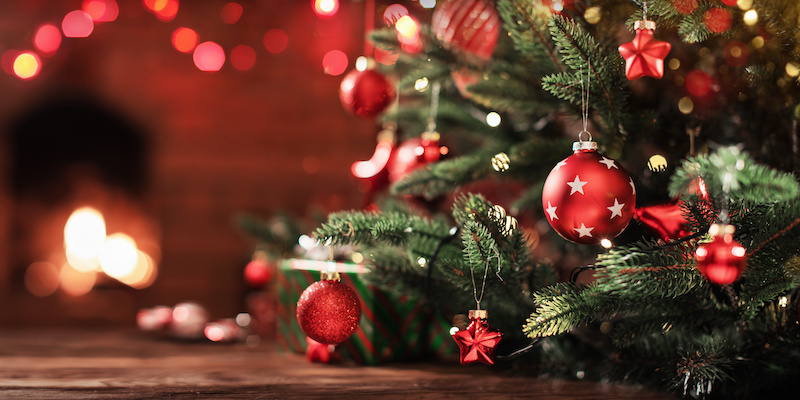We all love a tradition, don’t we? Whether it’s been passed down to us or we’ve adopted it ourselves, traditions bond us as families, friends or communities. They give us a warm, cosy feeling that we are part of something bigger, doing what others have done long before us, letting us pleasingly sink into a long line of ancestors and future offspring. We are safe in numbers, in tradition; the rules are set and all we have to do is play our part. And traditions are fun, right? Just good old-fashioned innocent fun.
Well, that’s what I thought, too, until I actually dug into some of America and Britain’s most heart-warming traditions and followed their history all the way back to their completely bizarre roots.
In the US and Europe, we take a lot of our everyday habits and seasonal traditions to be universal, and harmless, but on closer inspection it turns out we are doing some very strange stuff on the daily!
Let’s start with an easy one: the simple handshake. I mean, do I know what I’m actually doing when I shake hands with someone?
I think I, like most people, had the vague knowledge that handshaking had something to do with demonstrating peaceful intent, reassuring my new acquaintance that I didn’t have a massive weapon hidden behind my back ready to finish them off as soon as I got close enough.
But what I didn’t know about shaking hands is that the gesture has been in use for at least 3000 years —first evidenced in a 9th Century BCE relief that depicts the then King of Assyria forging an alliance with the King of Babylon. It was a gesture used to seal political, constitutional, bonds.
You see, handshakes aren’t just polite, they are promises; they are used in oath making.
Perhaps something to think about the next time you meet a realtor or a car dealer.
But in this day and age what exactly are we promising with a handshake? Perhaps in a sense we are making the same promise as those ancient kings: I will enter into a state of trust with you as long as you also maintain that bond.
Perhaps odd that you would need to express that sentiment, for example, at the start of a business lunch, but then you would notice if someone left you hanging, wouldn’t you?
At first being left hanging might seem funny, idiosyncratic, but then afterwards we might reassess. We might even begin to fixate on the interaction, slightly distrust the person or ourselves and just straight-up ask ourselves: but why the hell didn’t they just shake hands? What are they trying to prove?
Which leads me to conclude that a handshake is as important now as it ever was because our innocent little social tics are signals, signals to others that — whether we ourselves understand them, or not — we agree to play together by ancient rules. We will care, we will protect, we will respect, or fear, or love. And sure, your entire heart and soul might not be behind that handshake with Craig from Marketing, but the act itself is enough. You are signalling that you will give Craig the same treatment you would give a king — and so what if it is only goodwill in deed and not in thought. At the end of the day, deed is all most people really need from you.
Traditions, habits and customs are the secret sauce that holds our days and society together. They are more about our willingness to play the game than anything else, they are gestures that reveal we know the rules and we promise to play fair only to the extent everyone else does.
While researching my latest novel, The Family Game, set around the holiday season and its vast array of customs, I fell down a rabbit hole of tradition: the family and the seasonal varieties.
Questions followed hard and fast on the back of each other: why do we bring trees inside, who is Santa, how does a Roman Catholic Saint have flying reindeer, and elves, is there a naughty list, and what’s all this about lumps of coal? My Christmas list goes on…
Let’s start with the trees. Christmas trees are evergreens and, at least to the non-horticulturalist, appear to never die. Pagan cultures often used evergreen as protection to banish the devil or death itself from their homes due to the fact its branches appeared to possess immortal or resurrective properties.
The tradition of having a full tree in the house stems from Germany where devout Christians would set up Paradise Trees in their homes. These Garden of Eden inspired trees (of Adam and Eve fame) would be festooned with apples and wafers, in a nod to both the tree of Knowledge and the Eucharist. Though the wafers latterly became cookies.
Queen Victoria’s Husband, Prince Albert, is often credited with having introduced the Christmas tree to British culture, but Albert, the prototypical Manic Pixie Dream boy, and introducer of lots of other fun stuff as well as being quite the whizz in the sack (nine kids?!), was not the first German spouse to drag a tree into a royal British Sitting room. The first recorded use of a Christmas tree, at least in an official setting, appears to be by Queen Charlotte, the German wife of George III, who requested an evergreen tree be erected and decorated at Queen’s Lodge, Windsor, in December 1800, nineteen years before Albert was even born. Though I do concede that Albert, being very much the Harry Styles of the 1800s, would invariably have given the trend more traction when he got behind it half a century later.
In terms of the Christmas tree making its way into American living rooms, the tradition of decorating a seasonal tree had of course travelled across to America with the earliest Germany settlers, but it wasn’t until Albert’s adoption that the Christmas tree really hit the big time and became a festive (and often, entirely secular) must have.
But what about the flying reindeer, I hear you scream, go back to that bit? How did a fusty old dead saint get hooked up with a jaunty red suit and a gang of flying mammals?
Well let’s tackle the big man first: St. Nic.
So, here are the facts: Father Christmas was in reality a 4th Century bishop from Myra (now Turkey) and he got his reputation for leaving gifts in children’s houses after hearing that a man (he didn’t know) couldn’t afford to settle dowries for his three daughters. In order to prevent said daughters from being forced into prostitution, apparently the alternative to marriage at the time, St. Nicholas (just Nicholas back then I’d imagine) snuck over to the man’s house and threw a big bag of gold coins through their open window. So far so Christmas stocking filler, right?!
Anyway, Nicholas came back to the family’s house three nights in a row throwing a bag of coins every time, and on the final night the father of the girls caught Nicholas in the act, and overcome with gratitude, showered him with thanks. Nicholas told him not to make too much of a fuss about the whole thing or tell anyone what a lovely guy he was as it would only spoil it – and then, after a bit, the Catholic church made him a saint.
St. Nicholas’s feast became a new calendar fixture, every early December, encouraging people to give small token gifts to good children and twigs or coal to bad ones.
And the red suit? Well, that was his Bishop outfit, though obviously the pointy hat appears to have flopped slightly over time.
But what about the airborne reindeer, I hear you still screaming?
Ok, so here’s where things get a little confused: in Northern European mythology the Norse God Thor rode about in a chariot pulled by two flying goats, but here’s my point—Thor is translated as ‘Donar’ in German. Sound familiar?
Not much is available in terms of connecting the dots here—which seems to imply that a lot of the Santa Claus myth has developed through the oral tradition—the first written mention of the reindeer pulling Santa’s sleigh being in a poem from 1821. But the reindeer aren’t flying in that they’re just reindeer.
Then in 1891 the US government, in connection with the Sami people of Northern Norway, brought over 539 reindeer and 418 sleds in a one-off project to introduce reindeer husbandry to Alaska and teach local Inuit people to herd and breed the animals.
Reindeer numbers soared and to promote the sale of furs and meat in the US, the company responsible, in collaboration with Macy’s department store, began staging an annual Christmas parade featuring Santa Claus and teams of Sami and Alaskan herders driving teams of reindeer – linking the two together visually for the first time.
But then when did they start flying???
Oh, that? That was just some copywriter working for a toy store who had to come up with a free Christmas giveaway colouring book for children. And Rudolph the flying reindeer was born.
But don’t be disappointed, there’s still a lot of magic in all this, I promise, and a lot more, weird, macabre, old stuff…like Krampus (the 9ft devil monster who accompanies Santa everywhere?!), and hessian sacks that bundle you up to hell, and magic evergreen rods that banish the devil, and of course leaving your shoes out on the 5th December.
But to find out about all that juicy, weird, very unsettling stuff you’ll have to grab a paperback copy of my new book.
Oops, I’ve only gone and made it too commercial, haven’t I?
***


















